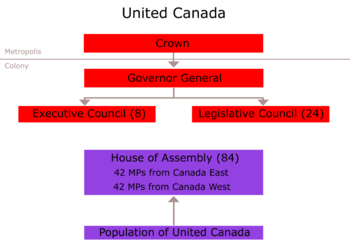Act of Union 1840
The British North America Act, 1840 (3 & 4 Victoria, c.35),[1] commonly known as the Act of Union 1840, was enacted in July 1840 and proclaimed February 10, 1841. It abolished the legislatures of Lower Canada and Upper Canada and established a new political entity, the Province of Canada to replace them. This act effected the political union of the Province of Canada, and was similar in nature and in goals to the other Acts of Union enacted by the British Parliament.
History

The inspiration for the act is typically attributed to Lord Durham's Report on Canada. Lord Durham was sent to the colonies to examine the causes of the Rebellions of 1837 in both Upper and Lower Canada. Lord Durham wanted to re-instate peace throughout the colonies, and recommended a political union. It was under his belief that peace could best be achieved by ensuring a loyal English majority in British North America, as well as by anglicizing French Canadians, and by granting responsible government.[2] The union was also proposed to solve pressing financial issues in Upper Canada, which had become increasingly indebted [3] under the previous regime dominated by the Family Compact. These debts stemmed mostly from poor investments in canals [4] connecting Upper Canada to the port of Montreal in Lower Canada via the Great Lakes and St-Lawrence river. Due to Upper Canada's considerable debt and chronic budget shortfalls, it was hoped that its finances could be salvaged by merging it with the then-solvent Lower Canada.
Upper Canada, with its British and Protestant majority, was growing more rapidly than Lower Canada, with the French-Canadian and Catholic majority. It was hoped that by merging the two colonies, the French-Canadian cultural presence in North America would gradually disappear through assimilation. As such, the act also contained measures banning the French language from official use in the Legislative Assembly. However, despite the amalgamation, the distinct legal systems of the two colonies was retained with Upper Canada becoming referred to as Canada West (with English common law) and Lower Canada as Canada East (with French civil law). In Upper Canada, there was opposition to unionization from the Family Compact, while in Lower Canada political and religious leaders reacted against Upper Canada's anti-French measures.[5]
The new, merged colony was named the Province of Canada and the seat of government was moved to Kingston by Lord Sydenham. Canada West, with its 450,000 inhabitants, was represented by 42 seats in the Legislative Assembly, the same number as the more-populated Canada East, with 650,000 inhabitants. The French-Canadian majority as well as numerous anglophones considered this an injustice. In Lower Canada, Louis-Joseph Papineau demanded representation by population and the recall of the union the minute he entered the new parliament of the united Canadas.

The granting of responsible government to the colony is typically attributed to reforms in 1848 (principally the effective transfer of control over patronage from the governor to the elected ministry). These reforms resulted in the appointment of the second Baldwin-Lafontaine government that quickly removed many of the disabilities on French-Canadian political participation in the colony.
By the late 1850s, massive immigration from the British Isles to Canada West changed the previous demographic imbalance between the English and French sections of the colony. Many politicians in Canada West began to lobby for representation by population as they no longer considered the equal representation mandated by the Act of Union to be just.
In the end, the Act of Union failed at shutting down French-Canadian political influence, especially after responsible government was granted to the colony. By voting en bloc while the anglophones of Canada West were highly factionalized, the francophones of Canada East guaranteed a strong, unified presence in the legislative assembly. As a result, bills proposed by one of the anglophone Canada West factions required the support of the francophone Canada East votes to be passed. This was known as the double majority principle.
However, the francophone presence remained inferior to their demographic weight in the executive and legislative councils. The government of Lafontaine-Baldwin succeeded in repealing the measure against the French language in the assembly, in the courts, and in the civil administration. With the double majority principle, both Canadas were so to speak "reseparated" and for a short while, both sides were managed independently. Joint premierships shared by an anglophone from Canada West and a francophone from Canada East became the convention, but continual legislative deadlock resulting from the conflicting aspirations of the two Canadas, remained. Dissatisfaction resulting from this deadlock was one of the main factors for Canadian Confederation in 1867.
See also
- Act of Union (disambiguation)
- Constitutional history of Canada
- History of Quebec
- Lower Canada Rebellion
- Report on the Affairs of British North America
- Quebec nationalism
- History of Canada
References
- ↑ The Short Titles Act 1896, section 1 and Schedule 1.
- ↑ ARCHIVED - Upper Canada - Towards Confederation - Canadian Confederation - Library and Archives Canada. Collectionscanada.gc.ca. Retrieved on 2013-07-12.
- ↑ Canadian Journal of Political Science / Volume 26 / Issue 04 / December 1993, pp 809-809Copyright © Canadian Political Science Association (l'Association canadienne de science politique) and/et la Société québécoise de science politique 1993 doi:10.1017/S0008423900000597
- ↑ Canadian History. Flash.lakeheadu.ca. Retrieved on 2013-07-12.
- ↑ Act of Union Archived March 14, 2013, at the Wayback Machine.. The Canadian Encyclopedia. Retrieved on 2013-07-12.
External links
- Full text of the act
- Canadian Encyclopedia - Act of Union
- Canada in the Making, 1839 - 1849: Union and Responsible Government